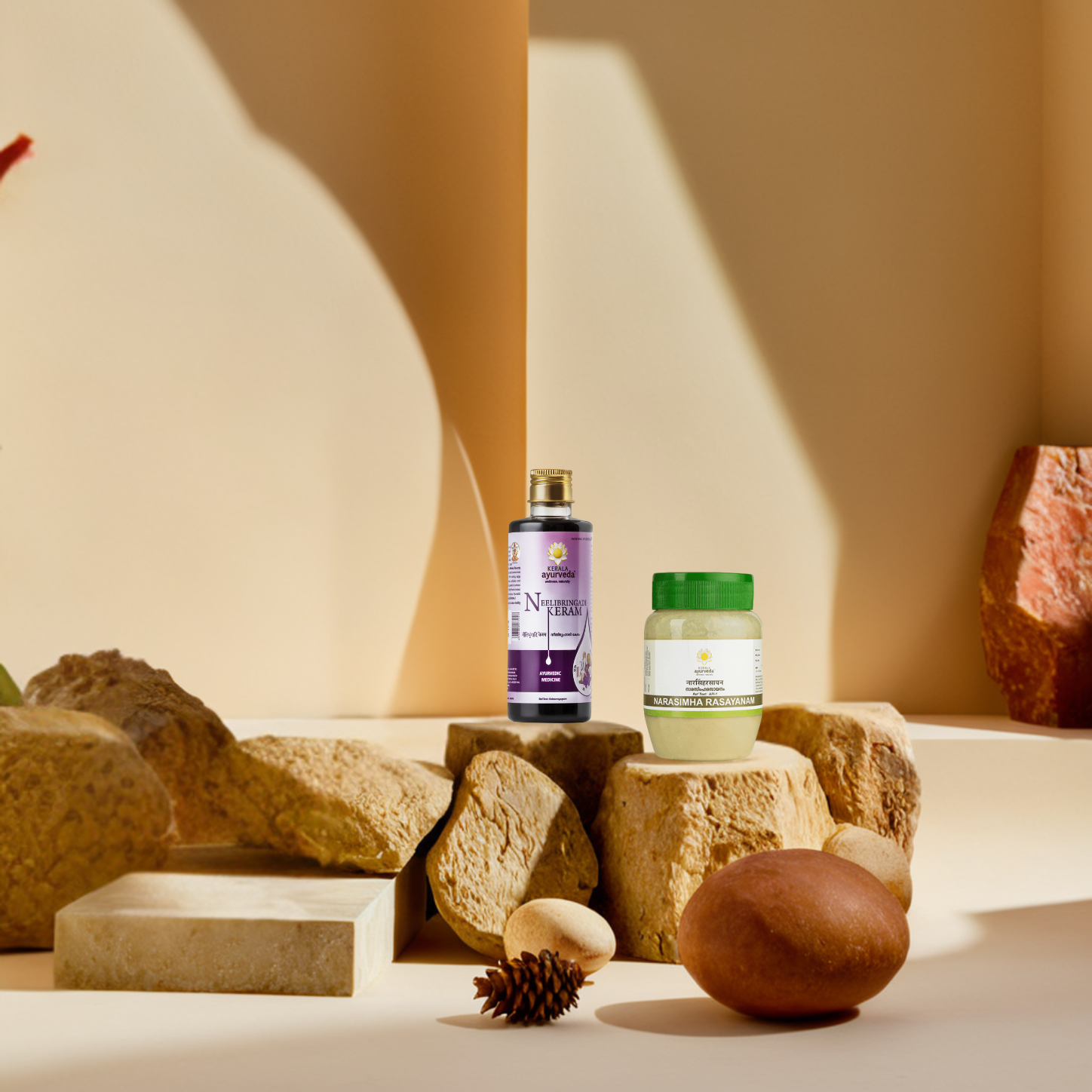The growing popularity of Ayurveda has raised a demand for herbal supplements over the last few years. Ancient Ayurvedic texts discuss many herbal formulas that help with different health needs. When used in the right way, with the proper amount and supporting ingredients, they can work really well by addressing the main cause of the health issue.
Ayurvedic remedies come in many forms, such as tablets, syrups, capsules, and oils. These are called Kalpanas, or types of Ayurvedic medicines. The idea is to take raw herbs and turn them into something easier to use, depending on what the body needs.
One common form is Kwath, also known as Kashayam. It is made by boiling herbs in water until the water reduces. This process brings out the water-based parts of the herbs and is simple to prepare. While Kwath is simple to prepare, it does have some challenges.
Arishtam: A Superior Ayurvedic Solution
To overcome the limitations of Kwath, Ayurveda introduced other forms of herbal preparations like Arishtams and Asavas, made through a special process known as Sandhana Kalpana. These herbal liquids contain both water-soluble and alcohol-soluble components of the herbs, making them more potent. The process of fermentation naturally produces alcohol, which enhances the effectiveness of the herbs and extends their shelf life.
Sweet ingredients like jaggery or raw sugar are added to start the fermentation, making Arishtams taste better and last longer. That’s why Arishtams and Asavas are often considered superior to Kwath.
Method of Preparing Ayurvedic Arishtam
The traditional preparation of Arishtam follows a careful process that enhances the medicinal properties of herbs. Here's how it's done:
- First, a decoction or Kashaya of the herb is prepared. One part of coarse herb powder is mixed with sixteen parts of water. This is boiled in an open vessel until the water level is reduced to one-fourth or one-eighth. It is then filtered.
- A fixed amount of sweetener, such as jaggery or raw sugar, is added to this filtered decoction. The mix is stirred well so that the sweetener fully dissolves, and then it is filtered again.
- Next, natural fermenting agents like the flowers of Dhataki (Woodfordia fruticosa) or Madhuka (Madhuca longifolia) are added.
- A group of selected herbs is also added. These herbs help control the speed of fermentation and add their own healing benefits, depending on what the Arishtam is meant to support.
- This mixture is poured into mud or wooden containers until they are two-thirds full. The containers are then sealed and kept still for two to eight weeks, depending on the formula.
- During this time, the sugar in the sweetener breaks down naturally and forms alcohol.
- The decoction already has water-based herb qualities. These become more active in the alcohol-based liquid.
- By the end of this process, both water-soluble and alcohol-soluble parts of the herbs are fully present in the final Arishtam. This herbal wine is filtered and stored in air-tight bottles away from sunlight.
Did you know: The ruby red flowers of Woodfordia fruticosa, known as Dhataki pushpa, help start the natural fermentation. They also add color and taste to the Arishtam. These flowers are a natural source of yeast, which is why Arishtam can ferment on its own without any artificial help.
Top Health Benefits of Arishtam
Arishtam has many benefits because of how it is made. Here are some reasons why it is useful in Ayurveda.
- It supports digestion, which is an important part of healing in Ayurveda. The body’s digestive strength, known as Ama, plays a big role in keeping us healthy.
- Because Arishtam is made using both water and alcohol as the base, it is absorbed quickly by the stomach and intestines.
- Easy absorption makes it easier for the supplement to be distributed throughout the rest of the body. Its ability to spread fast in the body is explained in Ayurveda as Vyavayi.
- Arishtam can be stored for a long time, unlike Kashayam. Kashayam can be stored for just about 24 hours, but considering the use of alcohol, Arishtam can be kept longer.
- The sweet-spicy flavor of Arishtam makes it easier to take. The sweetening agents help cover the bitter and strong herbal tastes.
- It often contains spices that support digestion and improve the body's metabolism.
Arishtam is an excellent way for individuals to improve their digestive levels. Since Arishtam helps balance digestion, it also supports overall well-being. The specific benefits depend on the herbs used in each type of Arishtam. Let’s know the right way to consume it.
Dosage of Arishtam
The usual dose of Arishtam is between 15 and 25 ml. This can be taken once or more in a day. It may be taken before or after meals depending on the condition being treated.
For children, the dose is smaller — about 1 to 2 teaspoons (5 to 15 ml). This is usually taken after meals twice daily or as advised by a doctor.
For best results, regular use for two to three months is recommended. If you are prone to acidity, you can take it along with half a teaspoon of ghee and avoid using it at night.
Arishtam is not recommended for pregnant women or nursing mothers.
Difference Between Arishtam and Kwath (Water Decoction)
Here are some basic differences between arishtam and kwath:
- Arishtam contains both water-soluble and alcohol-soluble parts of the herbs, while Kwath has only water-soluble parts.
- Arishtam takes a few days to prepare. Kwath can be prepared in a day.
- Arishtam can last for many years. Kwath has a much shorter shelf life.
- Arishtam has a sweeter and more pleasant taste because it contains sugar or honey. Kwath, made by boiling herbs in water, usually tastes bitter or astringent.
- Due to the sweetness, large amounts of care must be taken while using Arishtams in people with diabetes.
- Since Arishtam is based on both water and alcohol, it is absorbed well in the stomach and intestines and spreads easily through the body.
Difference between Arishta and Asava
Arishtam and Asavam are quite similar but have some preparation differences:
- In Arishtam, the process starts with making Kwath (a decoction of the herb). Then, sweeteners, fermenting agents, and spices are added.
- In Asavam, all ingredients, including sweeteners, herbs, and spices, are added directly to water, and then the mix is fermented.
So while Arishtam involves boiling the herbs first, Asavam uses them in raw form and steeps them in water.
Kerala Ayurveda's Arishtams
Kerala Ayurveda has a variety of Ayurvedic arishtam and Asavam products. Each one is made with care and meant to help with a specific health issue. Some of the popular ones include:
1. Balarishta
This herbal wine combines ingredients like Bala (Sida cordifolia), clove, cardamom, and castor root to help strengthen muscles and joints. It relieves numbness and calms the Vata dosha. The blend nourishes the nerves and supports better sensation, making movement easier and more balanced. It deeply nourishes weak muscles, bones, and joints to help you lead an active and joyful life.
2. Dasamoolajeerakarishta
Made with cumin and Dasamoola—a group of ten anti-inflammatory roots—this Arishtam improves digestion and metabolism. It’s widely used for post-partum care to help new mothers recover after childbirth. The herbs can help balance hormone levels and uterine function, giving mothers more energy and a positive outlook. It also addresses digestive issues that may arise during and after pregnancy.
3. Dasamoolarishta
This Ayurvedic digestive aid features a powerful blend including Dasamoola, Chitraka (Leadwort), Giloy (Guduchi), Triphala, Jeeraka (Cumin), Draksha (Grapes), honey, jaggery, and other herbs. It helps relieve indigestion and bloating, restores appetite, and supports overall gut health and metabolic fire.
4. Abhayarishta
Abhayarishta is made by fermenting a decoction of herbs such as Abhaya, Draksha, and Vidanga along with jaggery. It’s a classical preparation that greatly supports digestive health by providing quick relief from constipation. This natural, non-habit-forming supplement promotes smooth bowel movements and helps with issues like abdominal distension, flatulence, and gas troubles.
5. Amrutharishta
With Giloy as its key ingredient, this Arishtam is a strong antipyretic remedy that helps overcome weakness after illness. It contains Dasamoola which improves appetite and fights fatigue caused by debilitating conditions. It also helps soothe coughs and colds, keeps body temperature balanced, and relieves symptoms like irritation and itching in intimate areas before and after monthly cycles.
6. Aragwadharishta
The main ingredient here is Cassia fistula, known as an excellent skin tonic herb. Along with clove, cardamom, black pepper, honey, and amla, this Arishtam treats skin disorders, non-healing wounds, fistula, and hemorrhoids. It contains natural laxatives that support healthy bowel movements. It also purifies the blood, acts as a nervine tonic, helps overcome fatigue from illness or poor nutrition, reduces stress, and improves digestive fire.
7. Asokarishta
“Asoka” means “without sorrow,” and this medicine is known for easing women’s worries. Enriched with Asoka, Utpala, and Amrasthi, this Arishtam helps strengthen and rejuvenate the uterus and related organs. It supports hormonal balance, soothes hot flashes, eases vaginal discharge, and helps regulate the menstrual cycle for better overall reproductive health.
Conclusion
Arishtam is a time-tested Ayurvedic herbal wine that offers powerful benefits for digestion, immunity, and overall health. Its unique natural fermentation makes it more effective and easier to take than other herbal remedies. With Kerala Ayurveda’s trusted Arishtam range, you can experience authentic wellness rooted in tradition, helping you feel balanced and energized every day.
FAQs
1. Can Arishtam be taken daily?
Yes, but it should be taken as per the recommended dose and guidance from an Ayurvedic practitioner.
2. Is Arishtam safe for children?
Children can take Arishtam in smaller doses, usually after meals, as advised by a physician.
3. What is Dasamoolarishtam and what are its benefits?
Dasamoolarishtam is a liquid Ayurvedic medicine used to treat anemia, support post-delivery care for mothers, and relieve cold, cough, and digestive problems.
4. Which Arishtam is good for weak bones?
Balarishta and Dasamoolarishtam are beneficial for weak bones. They help reduce pain, swelling, and stiffness while supporting overall bone and joint health.
5. What is the shelf life of Arishtam?
Arishtam typically has a shelf life of up to 10 years when stored properly.





